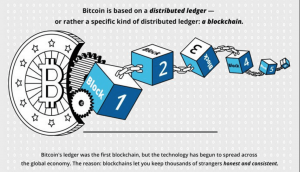Bitcoins
Bitcoin is an open source software created by someone or some group with alias of Satoshi Nakamoto with unknown motive. The fact that it’s creator is unknown added to the fact that due to its digital nature it is not belonged to any particular country, it is not regulated by any central bank. Despite bitcoin’s anonymity and security, it is criticized for being used for illegal transaction, and the lack of regulation means it is extremely volatile and prone to inflation in the form of creating an economic bubble.[3]
Contents
History
Creation
Although There are many speculations about bitcoin being created as a means of ponzi scheme, it is believed Satoshi Nakamoto created bitcoin to fight against the flaws of the established banking system. [4]Soon after the Lehman Brothers in 2008 the domain bitcoin.org was registered and Satoshi Nakamoto published a paper explaining how cryptocurrency will work. On January 3rd 2009 the genesis block was created with the hidden message of “The Times 03/Jan/2009 Chancellor on brink of second bailout for banks.” – it is the first block of the bitcoin’s block chain. [5][6]After creating bitcoin Satoshi Nakamoto encouraged other cryptographers to improve the code of bitcoin, but on April 23rd, 2011 Satoshi Nakamoto released a statement “I’ve moved on to other things” and never surfaced since.[7]
Usage
The first recorded transaction using bitcoin was when Laszlo Hanyecz a programmer offered 10,000 bitcoins for a pizza, and a British man took up the offer and ordered a pizza to Laszlo’s Florida residence. [8]In 2011, Silk Road, an online dark-web marketplace with a cash flow of at least 213 million dollars was founded by Ross Ulbricht.[9] Initially, his intention was to empower consumer and producer privacy, but the anonymity made it a perfect platform for trading illegal items such as drugs and fake IDs. [10]
Evaluation
Bitcoin was first evaluated to $0.3 per coin when it was first made, but as it becomes an accepted form of payment in more and more places and as more methods of liquidating bitcoin to cash its value begin to skyrocket. [4]The biggest jump happened in 2017 whereby the price started at $998 per coin at 2017 and rose to all time high of $19,666 per coin on December 17th, 2017.[11] However, soon after that the bubble was broken and it dropped back down to $3845 per coin.
Design
Blockchain
Bitcoin is one of the first advocates of using blockchain as a means of protecting its information from potential hackers looking to get monetary gains by manipulating its data. [12]The idea of blockchain was first conceptualized at 1991 by W. Scott Stornetta, and it is essentially a linked list of blocks where the blocks are linked by storing the hash of the previous block. [13]It is a distributed ledger anyone can access, and once a block is created it is essentially immutable. [2]In addition to hash of previous block, each block contains transaction record and hash of the block. A hash is best understood as a fingerprint that identifies each block and is always unique.[14]
Security
One of the fundamental protection mechanisms of a blockchain is its unique alphanumeric hash value, calculated using the SHA-256 function using the information within the block. [15]Meaning if the transaction data within the block is to be changed, its hash value will have to change causing a discrepancy between said block and the block in front of it and it can’t be fixed unless all the hash values of every block in front of said block is changed. [16]Using the SHA-256 function each block has what’s known as proof of work because it takes a lot of computational time to calculate the hash values, making it infeasible to edit every block in a blockchain. [17]In addition, using the fact that it is publicly accessible the blockchain utilizes peer-to-peer network as its second line of defense in which every miner known as node has a copy of the block chain. As a result, when a new block is added, it is verified by the peer-to-peer network and needs to be approved by more than 50% of the network to be accepted. As a result, to tamper the block chain one would need to tamper almost every block on 50% of the network. [15]
Mining
Each person mines bitcoin by being a node for the peer-to-peer network of the blockchain of bitcoins. Moreover, the miners computers are used to do the calculation for proof-of-work for new blocks, by running the bitcoin’s software. [18]Since the function to calculate such proof-of-work requires lots of computational power, it causes huge electricity consumption. [19]Add that to the fact that the more nodes there are in a peer-to-peer network the more secure bitcoin is, miners are rewarded with bitcoins for their work.
Ethical Implications
Illegal Transactions
Due to the anonymity nature of bitcoin, it is used by many as a means of doing illegal transactions without leaving any trace behind. This means the police cannot build a case against neither the seller nor the buyer because technically bitcoins are not owned by any one entity and without digital footprint it’s impossible to prove ownership. Most notable example of such exploitation is the Silk Road founded by Ross Ulbricht where drug dealers sell drugs indiscriminately to anyone with access to internet. [9]Moreover, sites like idgod and fakeidvenders sells custom made fake ids through transaction using bitcoins. [20]The US government even claim that Russian hackers used bitcoins to fund their interference of US election without trace. [21]For the same reason bitcoin is good for trafficking illegal goods, it is also good for money laundering as it provides means of moving large amount of cash discretely. [22]
Energy Consumption
In order for bitcoin to be secure it needs to make sure every block have proof-of-work that requires enough computational power so that it is infeasible for potential hackers to tamper the transactions through brute force. [2]It also requires lots of nodes in the peer-to-peer network to ensure fidelity when new blocks are added.[23] In order to exert this much computation power and store this much data, a lot of energy is consumed by each bitcoin miner. In fact, by the end of 2017 it is estimated that bitcoin mining operation has combined to use between 1 to 4 gigawatt of energy, so its security and privacy is not without a high cost. [24]
Transparency and Security
Despite its obvious drawback of being used as means of illegal transactions, bitcoin provides the security and transparency that the current banking system does not provide. The fact that it is a distributed ledger, every transaction can be accessed by anyone instead of just those with access to bank records. As a result, something like the 2008 financial bubble could not happen with a purely bitcoin system because people can easily see the sudden illogical increase in high volume transactions. Moreover, the numerous security measure that blockchain provides makes it impossible to create fake bitcoin as oppose to printing fake money.
References
- ↑ "Here's a Simple, 60-second primer on Bitcoin" https://www.washingtonpost.com/news/wonk/wp/2013/04/03/heres-a-simple-60-second-primer-on-bitcoin/?noredirect=on&utm_term=.f516fd994ffb
- ↑ 2.0 2.1 2.2 "Blockchain Technology: Beyond Bitcoin" https://scet.berkeley.edu/wp-content/uploads/BlockchainPaper.pdf
- ↑ "More Nobel Prize Winners Snub Bitcoin"https://finance.yahoo.com/news/good-drug-dealers-nobel-prize-winners-snub-bitcoin-184903784.html
- ↑ 4.0 4.1 "The Cryptocurrency" https://www.newyorker.com/magazine/2011/10/10/the-crypto-currency
- ↑ "Genesis Block"https://www.blockchain.com/btc/block/000000000019d6689c085ae165831e934ff763ae46a2a6c172b3f1b60a8ce26f
- ↑ "Simple Decryption of Satoshi Nakamoto’s Hidden Message in the Blockchain" https://medium.com/splytcore/simple-decryption-of-satoshi-nakamotos-hidden-message-in-the-blockchain-42b5fe9b3c72
- ↑ "Everything you need to know about Bitcoin, its mysterious origins, and the many alleged identities of its creator" https://www.businessinsider.com/bitcoin-history-cryptocurrency-satoshi-nakamoto-2017-12
- ↑ "First Recorded Bitcoin Transaction"https://www.investopedia.com/news/bitcoin-pizza-day-celebrating-20-million-pizza-order/
- ↑ 9.0 9.1 "Silk Road: A Cautionary Tale about Online Anonymity" https://medium.com/@marcell74/the-silk-road-a-real-thriller-and-the-truth-about-the-anonymity-of-bitcoin-198b519ca397
- ↑ "The Feds Just Collected $48 Million from Seized Bitcoins" http://fortune.com/2017/10/02/bitcoin-sale-silk-road/
- ↑ "Bitcoin Evaluation" https://www.cnbc.com/quotes/?symbol=BTC=
- ↑ "A Survey of Blockchain Security Issues and Challenges" https://pdfs.semanticscholar.org/f61e/db500c023c4c4ef665bd7ed2423170773340.pdf
- ↑ "How to Time-Stamp a Digital Document" https://www.anf.es/pdf/Haber_Stornetta.pdf
- ↑ "Bitcoin:A Peer-to-Peer Electronic Cash System" https://s3.amazonaws.com/academia.edu.documents/54517945/Bitcoin_paper_Original_2.pdf?AWSAccessKeyId=AKIAIWOWYYGZ2Y53UL3A&Expires=1552612583&Signature=zhmIP4Hmet5GfsgPTpUzyCPzTw8%3D&response-content-disposition=inline%3B%20filename%3DBitcoin_A_Peer-to-Peer_Electronic_Cash_S.pdf
- ↑ 15.0 15.1 "Bitcoin and Blockchain Security" http://zran.org/wp-content/uploads/2018/07/Bitcoin-and-Blockchain-Security-2017-Artech.pdf
- ↑ "Decentralizing Privacy: Using Blockchain to Protect Personal Data" https://ieeexplore.ieee.org/abstract/document/7163223
- ↑ "Security Analysis of SHA-256 and Sisters" https://link.springer.com/chapter/10.1007/978-3-540-24654-1_13
- ↑ "The Economics of Bitcoin Mining or, Bitcoin in the Presence of Adversaries" https://pdfs.semanticscholar.org/c55a/6c95b869938b817ed3fe3ea482bc65a7206b.pdf
- ↑ "Bitcoin Mining and its Energy Footprint" https://digital-library.theiet.org/content/conferences/10.1049/cp.2014.0699
- ↑ "Bitcoins Worth $4.7 Million Seized in Fake ID Case" http://fortune.com/2018/02/09/bitcoin-seized-fake-id-case/
- ↑ "How Russian Spies Hid Behind Bitcoin in Hacking Campaign" https://www.nytimes.com/2018/07/13/technology/bitcoin-russian-hacking.html
- ↑ "Nobel-winning economist: Authorities will bring down 'hammer' on bitcoin" https://www.cnbc.com/2018/07/09/nobel-prize-winning-economist-joseph-stiglitz-criticizes-bitcoin.html
- ↑ "Decentralizing Privacy: Using Blockchain to Protect Personal Data" https://ieeexplore.ieee.org/abstract/document/7163223
- ↑ "Why the bitcoin craze is using up so much energy" https://www.washingtonpost.com/news/energy-environment/wp/2017/12/19/why-the-bitcoin-craze-is-using-up-so-much-energy/?noredirect=on&utm_term=.ff7d8278d8f1



